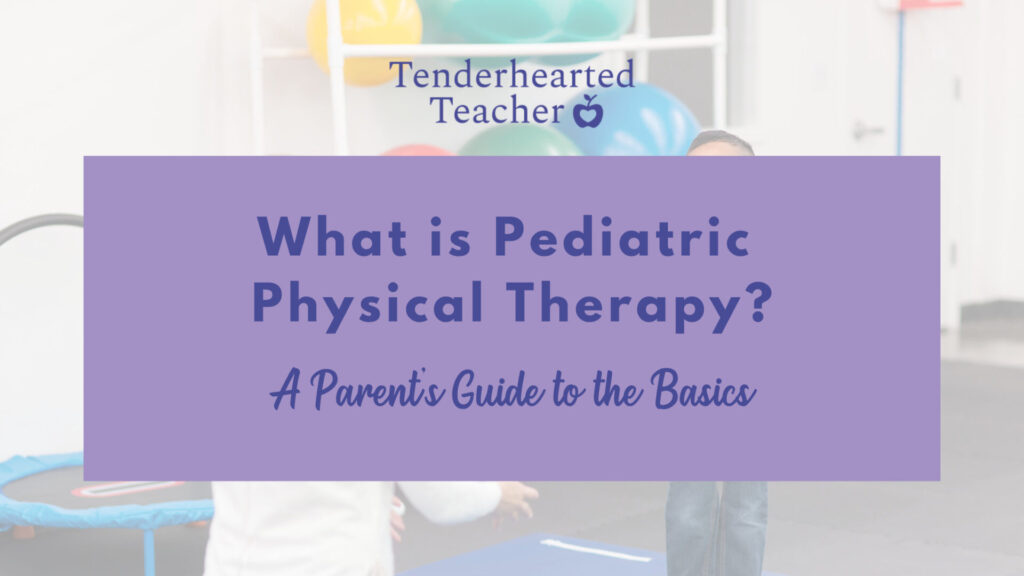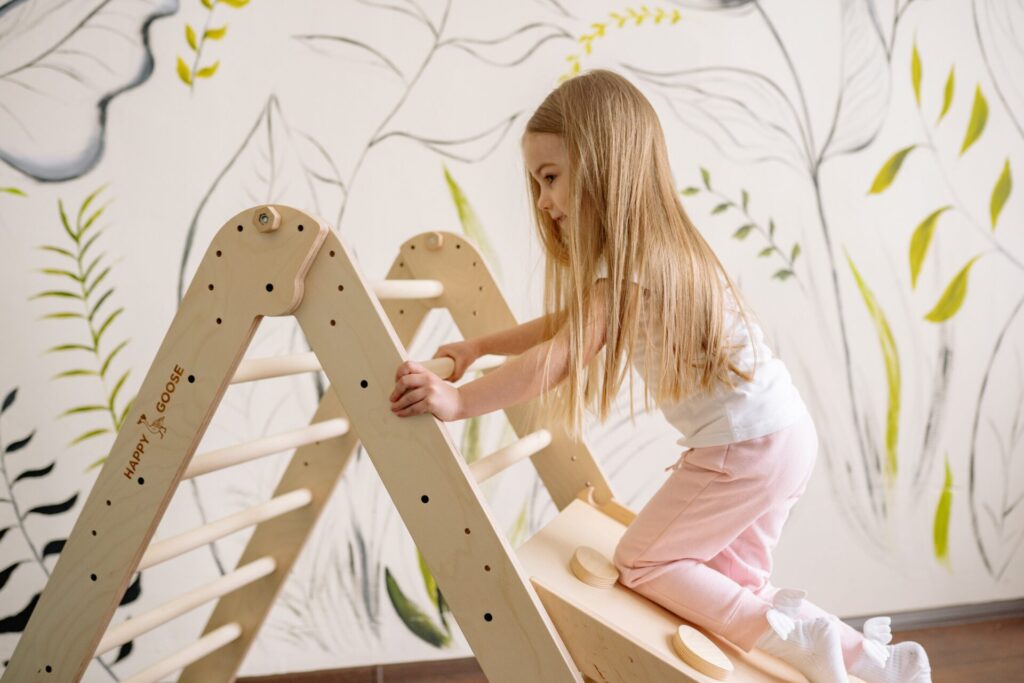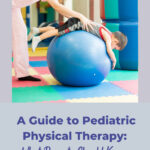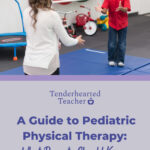
This is the third and final installment of my “Guide to Related Services” series. These are meant to provide information and resources for toddlers and preschoolers who aren’t yet meeting their developmental milestones. So far, we’ve discussed occupational and speech therapies. This time around, I’ve spoken to a physical therapist, who regularly works with young children, to learn more about pediatric physical therapy. She shares the basics, skills to look out for, and how to support your child at home.
What Is Pediatric Physical Therapy?
According to the Academy of Pediatric Physical Therapy (APTA), “ Physical therapists have expertise in movement, motor development, and body function (e.g.,strength and endurance.)” Therefore, pediatric physical therapists (otherwise known as PTs), “work with children and their families to assist each child in reaching their maximum potential to function independently and to promote active participation in home, school, and community environments.”
Kathleen Dunne, a school-based physical therapist, explains that pediatric physical therapy is a broad term that encompasses several areas that fall under either medical or educational models. For example, she notes that medical models include inpatient rehab and outpatient physical therapy where patients go to a facility to be treated.
“Under the educational model you have early intervention as well as school-based physical therapy,” she states. “Early intervention is provided for children ages 0 to 3 and occurs in the child’s least restrictive environment (which is generally the home.) School-based physical therapy begins when the child turns 3 and this therapy is performed within the school environment.”
Why Might A Child Need Pediatric Physical Therapy?
Pediatric physical therapy can target specific developmental delays and health conditions such as low muscle tone, gait abnormalities, and balance and coordination issues. Additionally, Dunne says that there are several developmental red flags parents and caregivers of preschoolers should look for at home. This is not a complete list, but these are common examples. An evaluation may be warranted if:
- your child has difficulty negotiating the stairs or they prefer to crawl on the stairs instead of walking
- they are unable to throw and catch a small ball
- the child exhibits hesitation on the playground equipment along with difficulty negotiating the equipment. “An example might be that the child can not go down the slide alone because of poor core strength,” she states.
- they frequently fall or exhibit loss of balance
- the child is unable to run and only walk with increase speed
- their head lags (or doesn’t stay in line with body) while sitting up from the supine position
- the child is unable to jump in place or on bouncy service like a bed, crib. or trampoline–even with their hands held by an adult
- they prefer to sit in “W” sitting on the floor
If your child is showing signs of developmental delays, it is important to speak to their pediatrician about how to obtain an evaluation. Parents can also reach out to their local school district to inquire about this process.
Dunne notes, “As previously mentioned, there are many models within pediatric physical therapy. Pediatricians often get confused and may recommend outpatient physical therapy which falls under the medical model. At this age, the ideal route is to determine if early intervention or school based physical therapy is necessary instead.”
What Can Parents Expect During An Evaluation?

During the evaluation appointment, the PT will sit with your child to observe their strength, balance, coordination, gross motor abilities, and ball handling skills. Dunne shared some examples of the types of questions they seek to answer:
- Can the child do a proper sit up with their hands and/or fingertips held?
- Can the child stand on their tip-toes with hands over their head and balance for a few seconds? Or can they stand on one foot for a few seconds?
- Can the child jump forward a few inches keeping their feet together on takeoff and landing?
- Can the child jump down from a small step stool or even a small chair?
- Can the child walk up and down the stairs placing 1 foot on each step in a reciprocal manner with the handrail or support from the wall?
What Happens During a Typical Session?
If a child qualifies for physical therapy, the PT will recommend a schedule based on their specific needs. For example, a child may need two 30-minute sessions per week.
The PT will also determine appropriate goals and objectives and then plan out activities to target each of these areas. This can and will look different for each individual child.
“For instance if they are demonstrating a weaker core area, a lot of times we will work on mat exercises. If they have trouble catching and throwing the ball, we will practice ball tossing while giving the necessary assistance needed to be successful. Within the school environment, we work a lot on negotiating the stairs so that the children can safely explore their environment,” Dunne states.
Ways Parents Can Support Their Child’s Development At Home
There are several ways to support your child’s gross motor development at home, regardless if they require physical therapy or not.
Dunne states, “Keeping the child active is the best for at home development. Kids should be walking on uneven surfaces, walking up and down stairs, going to the park to interact with other children and safely negotiate the equipment. They should also be able to safely get on and off adult size furniture and jump down from the bottom step.”
I’ve added a few of my own tips below:
1. Limit Screen Time and Get Moving!
Put down your phones and turn off the T.V., video games, and computers. Adults and children alike are spending more and more time in front of screens. But, the CDC recommends at least 60 minutes of vigorous physical activity for children 6 and up! The amount of exercise needed will depend on your child’s age, but all children should have opportunities to play, walk, run, jump, and climb every single day.
2. Spend Time Outside
Outdoor spaces provide great opportunities for physical activity. Go for walks or bike rides together in your neighborhood. Or visit your local playground and let your child climb equipment, hang on the monkey bars, and use the slides and swings. Read more about the benefits of outdoor play here.
3. Assign Household Chores
Giving your child opportunities to complete chores not only helps develop life skills and responsibility, but it also provides moderate physical activity. Let your child help you set the dining room table, load and empty the dishwasher and washer and dryer, and have them clean up their toys after playtime. These simple tasks may not seem like much but they help children develop important gross and fine motor skills.
4. Exercise As A Family
There’s no better way to motivate your child to exercise than to join in on the fun! You could have a dance party to your favorite music videos or songs. Play a quick game of basketball, soccer, or even tag. Or incorporate yoga into your daily routine.
Here are a few videos that I love to use in my classroom as well as at home with my toddler that help to encourage dance, exercise, and yoga!
To Wrap it Up
Physical therapy can greatly impact a child’s overall development. Treatment can help children more easily navigate their home and school environments as well as improve their independence and daily living skills.
Now talk to me! Do you feel well-versed on special services after having read this entire series? Please feel free to ask any questions or share your thoughts in the comment section below.
SAVE TO PINTEREST




So interesting! Love that this was broken up into a few posts to really get into detail. I love the idea of exercising as a family – so important in general for young kids to see their parents being active
You made a good point that spending time outdoors will also help a lot in the development of a child. I have a friend who would like to find pediatric therapy services because her daughter has been having problems speaking at school. Being able to find a therapist that could help her daughter be more comfortable at expressing herself will surely be a huge help.